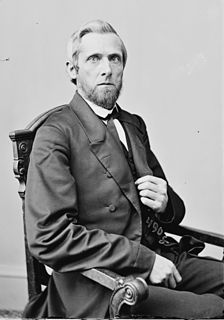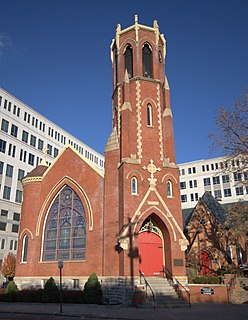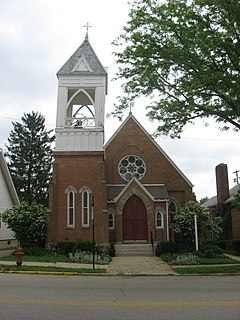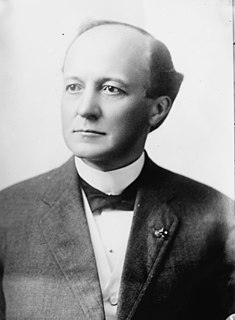
Asa Smith Bushnell I was a Republican politician from Ohio. He served as the 40th Governor of Ohio. Prior to becoming governor, he served as the president of the Warder, Bushnell and Glessner Company, which became one of four companies that merged to form International Harvester. Other roles in business included serving as president of the Springfield Gas Company and the First National Bank of Springfield.

John Marshall Hamilton was the 18th Governor of Illinois, serving from 1883 to 1885. Born in Union County, Ohio, Hamilton became interested in politics at a young age, joining the Wide Awakes when he was thirteen and the Union Army four years later. After graduating from Ohio Wesleyan University he studied law and was admitted to the bar. A notable attorney in Bloomington, Illinois, Hamilton was elected to the Illinois Senate in 1876. He served there until 1881, when he was elected Lieutenant Governor of Illinois on a ticket with Shelby Moore Cullom. When Cullom resigned after election to the United States Senate, Hamilton became Governor of Illinois. He was not selected as a candidate for re-election, but did serve that year as a delegate to the 1884 Republican National Convention. He spent the rest of his life as an attorney in Chicago, where he died in 1905.

Waitman Thomas Willey was an American lawyer and politician from Morgantown, West Virginia. One of the founders of the state of West Virginia during the American Civil War, he served in the United States Senate representing first the Restored Government of Virginia and became one of the new state of West Virginia's first two Senators.

Berlin is an unincorporated community and census-designated place (CDP) in central Berlin Township, Holmes County, Ohio, United States. As of the 2010 census it had a population of 898.

Louisville Gardens is a multi-purpose, 6,000-seat arena, in Louisville, Kentucky, that opened in 1905, as the Jefferson County Armory. It celebrated its 100th anniversary as former city mayor Jerry Abramson's official "Family-Friendly New Years Eve" celebration location. It was added to the National Register of Historic Places in 1980.

Peter Godwin Van Winkle was an American lawyer, businessman and politician. For many years a leading officer of the Northwestern Virginia Railroad, he became one of the founders of West Virginia and a United States Senator.

West Virginia Independence Hall is a historic government building at 1528 Market Street in downtown Wheeling, West Virginia, United States. It was built in 1860 under the supervision of architect Ammi B. Young for the federal government as a custom house, post office and courthouse. It is architecturally significant for its innovative uses of wrought iron as a framing material, and is historically significant for its role in the American Civil War. It housed the Wheeling Convention (1861), as well as the West Virginia Constitutional Convention (1863), which resulted in the separation of Unionist West Virginia from Confederate Virginia. This made it the only state to secede from a Confederate state during the war. The building was originally built as the custom house for the Western District of Virginia, and later became the center of government for the Restored Government of Virginia from 1861 to 1863, with Francis H. Pierpont serving as its governor. It was declared a National Historic Landmark in 1988. The building is now a state-run museum, housing exhibits on West Virginia history.
The 1928 Democratic National Convention was held at Sam Houston Hall in Houston, Texas, June 26–28, 1928. Keynote speaker was Claude G. Bowers. The convention resulted in the nomination of Governor Alfred E. Smith of New York for president and Senator Joseph T. Robinson of Arkansas for vice president.

Trinity Episcopal Church is located in Covington, Kentucky, Madison Avenue. This historic church was founded November 24, 1842, in a third floor of a brick building near the Covington market. The cornerstone of the first church was June 24, 1843 and the first service was on June 30, 1844. The church has served the people of Covington and Cincinnati, Ohio through wars and floods. The church is active today, with a large congregation at its Fourth and Madison Avenue location. The Rev. Peter D'Angio is the Rector and the Rev. Justin Gabbard is the associate Rector. It is the second largest parish in the Episcopal Diocese of Lexington.

Matthew Hueston House is a historic house located near Hamilton, Ohio.

John Vaughan House is a historic house near Shandon, Ohio.

The following is an alphabetical list of articles related to the U.S. state of Ohio.

The Franklin Township Hall, also referred to historically as the "Town Hall", is a town hall located in Kent, Ohio, United States, listed on the National Register of Historic Places. The building, located along Gougler Avenue in central Kent near the Cuyahoga River, was built in 1837 and has served as the seat of government for Franklin Township since 1840. It is best known for being the location where James A. Garfield was nominated for his first political office in 1859.

The Church of Our Saviour is a historic Episcopal parish in the village of Mechanicsburg, Ohio, United States. Founded in the 1890s, it is one of the youngest congregations in the village, but its Gothic Revival-style church building that was constructed soon after the parish's creation has been named a historic site.

Bellevue is a historic farmhouse located near the village of Kingston in southern Pickaway County, Ohio, United States. Built of brick on a stone foundation, it was the home of leading early Ohio politician Renick Dunlap.

The Robinson Center is a performance, convention, and exhibition space at Statehouse Plaza in downtown Little Rock, Arkansas.

The 1922 United States Senate election in Ohio took place on November 7, 1922. Incumbent Democratic Senator Atlee Pomerene ran for re-election to a third term in office, but was defeated by Republican U.S. Representative Simeon Fess.

The 1926 United States Senate special election in Ohio was held on November 2, 1926. Incumbent Republican Senator Frank B. Willis was re-elected to a second term in office, defeating former U.S. Senator Atlee Pomerene.

The 1916 United States Senate election in Ohio took place on November 7, 1916. Incumbent Republican Senator Atlee Pomerene was re-elected to a second term in office over Republican former Governor and Ambassador to France Myron Herrick.

High Street is a major thoroughfare in Central Ohio, predominantly in Franklin County and Columbus. It stretches from the northern border of Columbus in Delaware County south to the southern boundary of Franklin County just past Columbus's municipal boundaries. The street is considered one of Columbus's two main roads, along with Broad Street.





















